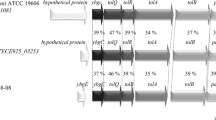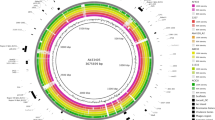Abstract
Acinetobacter baumannii, a non-fermenting gram-negative coccobacillus, is a major pathogen responsible for a variety of healthcare-associated infections, including pneumonia, urinary tract and bloodstream infections. Moreover, A. baumannii is associated with alarming increases in drug resistance rates to almost all available antibiotics leaving limited treatment options. Here, we characterize the biological functions of a novel gene, abrp, which encodes a peptidase C13 family. We demonstrate that the abrp is associated with decreased susceptibility to tetracycline, minocycline, doxycycline, tigecycline, chloramphenicol and fosfomycin. Deletion of abrp was able to increase cell membrane permeability and display slower cell growth rate. Results from the present study show that abrp plays an important role in conferring reduced susceptibility to different classes of antibiotics and cell growth in A. baumannii. The change of antibiotic sensitivities may result from modifications to the cell membrane permeability of A. baumannii.



Similar content being viewed by others
References
Dijkshoorn L, Nemec A, Seifert H (2007) An increasing threat in hospitals: multidrug-resistant Acinetobacter baumannii. Nat Rev Microbiol 5(12):939–951
Towner KJ (2009) Acinetobacter: an old friend, but a new enemy. J Hosp Infect 73(4):355–363
Gottig S, Gruber TM, Higgins PG, Wachsmuth M, Seifert H, Kempf VA (2014) Detection of pan drug-resistant Acinetobacter baumannii in Germany. J Antimicrob Chemother 69(9):2578–2579
Magiorakos AP, Srinivasan A, Carey RB, Carmeli Y, Falagas ME, Giske CG, Harbarth S, Hindler JF, Kahlmeter G, Olsson-Liljequist B, Paterson DL, Rice LB, Stelling J, Struelens MJ, Vatopoulos A, Weber JT, Monnet DL (2012) Multidrug-resistant, extensively drug-resistant and pandrug-resistant bacteria: an international expert proposal for interim standard definitions for acquired resistance. Clin Microbiol Infect 18(3):268–281
Perez F, Hujer AM, Hujer KM, Decker BK, Rather PN, Bonomo RA (2007) Global challenge of multidrug-resistant Acinetobacter baumannii. Antimicrob Agents Chemother 51(10):3471–3484
Peleg AY, Seifert H, Paterson DL (2008) Acinetobacter baumannii: emergence of a successful pathogen. Clin Microbiol Rev 21(3):538–582
Zhou H, Zhang T, Yu D, Pi B, Yang Q, Zhou J, Hu S, Yu Y (2011) Genomic analysis of the multidrug-resistant Acinetobacter baumannii strain MDR-ZJ06 widely spread in China. Antimicrob Agents Chemother 55(10):4506–4512
Ruzin A, Immermann FW, Bradford PA (2010) RT-PCR and statistical analyses of adeABC expression in clinical isolates of Acinetobacter calcoaceticus-Acinetobacter baumannii complex. Microb Drug Resist (Larchmont, NY) 16(2):87–89
Coyne S, Rosenfeld N, Lambert T, Courvalin P, Perichon B (2010) Overexpression of resistance-nodulation-cell division pump AdeFGH confers multidrug resistance in Acinetobacter baumannii. Antimicrob Agents Chemother 54(10):4389–4393
Mussi MA, Limansky AS, Viale AM (2005) Acquisition of resistance to carbapenems in multidrug-resistant clinical strains of Acinetobacter baumannii: natural insertional inactivation of a gene encoding a member of a novel family of beta-barrel outer membrane proteins. Antimicrob Agents Chemother 49(4):1432–1440
Nikaido H (2003) Molecular basis of bacterial outer membrane permeability revisited. Microbiol Mol Biol Rev 67(4):593–656
Clinical and Laboratory Standards Institute (2015) Performance standards for antimicrobial susceptibility testing. Twenty-Fifth Informational Supplement M100-S25. Clinical and Laboratory Standards Institute, Wayne
Amin IM, Richmond GE, Sen P, Koh TH, Piddock LJ, Chua KL (2013) A Method for generating marker-less gene deletions in multidrug-resistant Acinetobacter baumannii. BMC Microbiol 13(1):158
Aranda J, Poza M, Pardo BG, Rumbo S, Rumbo C, Parreira JR, Rodriguez-Velo P, Bou G (2010) A rapid and simple method for constructing stable mutants of Acinetobacter baumannii. BMC Microbiol 10:279
Li X, Liu L, Ji J, Chen Q, Hua X, Jiang Y, Feng Y, Yu Y (2015) Tigecycline resistance in Acinetobacter baumannii mediated by frameshift mutation in plsC, encoding 1-acyl-sn-glycerol-3-phosphate acyltransferase. Eur J Clin Microbiol Infect Dis 34(3):625–631
Lofton H, Anwar N, Rhen M, Andersson DI (2015) Fitness of Salmonella mutants resistant to antimicrobial peptides. J Antimicrob Chemother 70(2):432–440
Rost B, Yachdav G, Liu J (2004) The PredictProtein server. Nucleic acids research 32 (Web Server issue):W321-326
Novo DJ, Perlmutter NG, Hunt RH, Shapiro HM (2000) Multiparameter flow cytometric analysis of antibiotic effects on membrane potential, membrane permeability, and bacterial counts of Staphylococcus aureus and Micrococcus luteus. Antimicrob Agents Chemother 44(4):827–834
Novo D, Perlmutter NG, Hunt RH, Shapiro HM (1999) Accurate flow cytometric membrane potential measurement in bacteria using diethyloxacarbocyanine and a ratiometric technique. Cytometry 35(1):55–63
Nguyen FSA, Arenz S, Sohmen D, Dönhöfer A, Wilson DN (2014) Tetracycline antibiotics and resistance mechanisms. Biol Chem 395(5):559–575
Zasloff M (2002) Antimicrobial peptides of multicellular organisms. Nature 415(6870):389–395. doi:10.1038/415389a
Fillgrove KL, Pakhomova S, Newcomer ME, Armstrong RN (2003) Mechanistic diversity of fosfomycin resistance in pathogenic microorganisms. J Am Chem Soc 125(51):15730–15731
Fluhrer R, Fukumori A, Martin L, Grammer G, Haug-Kroper M, Klier B, Winkler E, Kremmer E, Condron MM, Teplow DB, Steiner H, Haass C (2008) Intramembrane proteolysis of GXGD-type aspartyl proteases is slowed by a familial Alzheimer disease-like mutation. J Biol Chem 283(44):30121–30128
Waite RD, Rose RS, Rangarajan M, Aduse-Opoku J, Hashim A, Curtis MA (2012) Pseudomonas aeruginosa possesses two putative type I signal peptidases, LepB and PA1303, each with distinct roles in physiology and virulence. J Bacteriol 194(17):4521–4536
Personne Y, Curtis MA, Wareham DW, Waite RD (2014) Activity of the type I signal peptidase inhibitor MD3 against multidrug-resistant Gram-negative bacteria alone and in combination with colistin. J Antimicrob Chemother 69(12):3236–3243
Garcia-Quintanilla M, Pulido MR, McConnell MJ (2013) First steps towards a vaccine against Acinetobacter baumannii. Curr Pharm Biotechnol 14(10):897–902
McConnell MJRC, Bou G, Pachón J (2011) Outer membrane vesicles as an acellular vaccine against Acinetobacter baumannii. Vaccine 29(34):5705–5710
Acknowledgments
We are extremely thankful to Kim Lee Chua (National University of Singapore) for giving pMo130-telR as a kind gift.
Author information
Authors and Affiliations
Corresponding author
Ethics declarations
Funding
This work was supported by the State Key Program of National Natural Science of China (grant no. 81230039), the Young Scholar of National Natural Science Foundation of China (grant no. 81201327) and the Natural Science Foundation of Zhejiang province, China (Grant No. LY15H190004).
Conflict of interest
The authors declare that they have no conflict of interest.
Ethical approval
Not required.
Informed consent
Not required.
Electronic supplementary material
Below is the link to the electronic supplementary material.
Fig. S1
Amino acid sequence alignment of abrp. Sequence alignments were analysed with CLUSTAL X (http://www.clustal.org/clustal2/) and formatting using the ESPript server (http://espript.ibcp.fr/ESPript/cgi-bin/ESPript.cgi). The accession numbers of abrp homologues from different bacteria are shown in brackets, including Acinetobacter baumannii (ATCC 17978), Acinetobacter pittii (WP_016144399, 85 % identity and 91 % similarity), Acinetobacter junii (WP_039047158, 84 % identity and 91 % similarity), Pseudomonas fluorescens (WP_038443591, 40 % identity and 57 % similarity), and Pseudomonas aeruginosa (WP_034031112, 36 % identity and 55 % similarity). The predicted secondary structural elements of abrp in A. baumannii are displayed on the lines above the sequence alignment using PSIPRED (http://bioinf.cs.ucl.ac.uk/psipred/). The arrows indicate β-sheet, and the coils indicate α-helices. Strictly conserved residues have a red background and are indicated by bold letters; residues conserved between groups are boxed. (PPTX 1244 kb)
Table S1
(DOCX 17 kb)
Table S2
(DOCX 18 kb)
Rights and permissions
About this article
Cite this article
Li, X., Quan, J., Yang, Y. et al. Abrp, a new gene, confers reduced susceptibility to tetracycline, glycylcine, chloramphenicol and fosfomycin classes in Acinetobacter baumannii . Eur J Clin Microbiol Infect Dis 35, 1371–1375 (2016). https://doi.org/10.1007/s10096-016-2674-0
Received:
Accepted:
Published:
Issue Date:
DOI: https://doi.org/10.1007/s10096-016-2674-0




